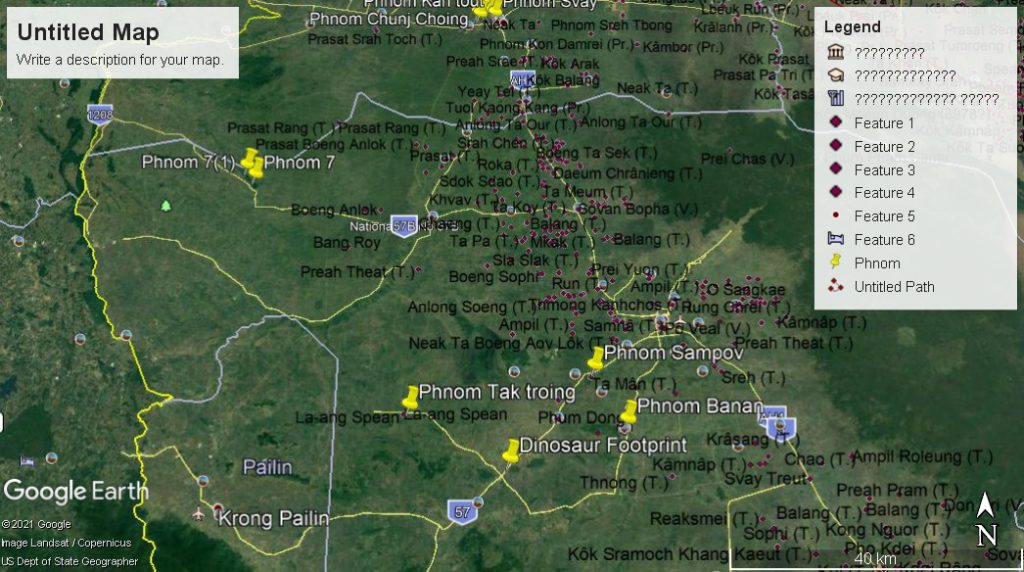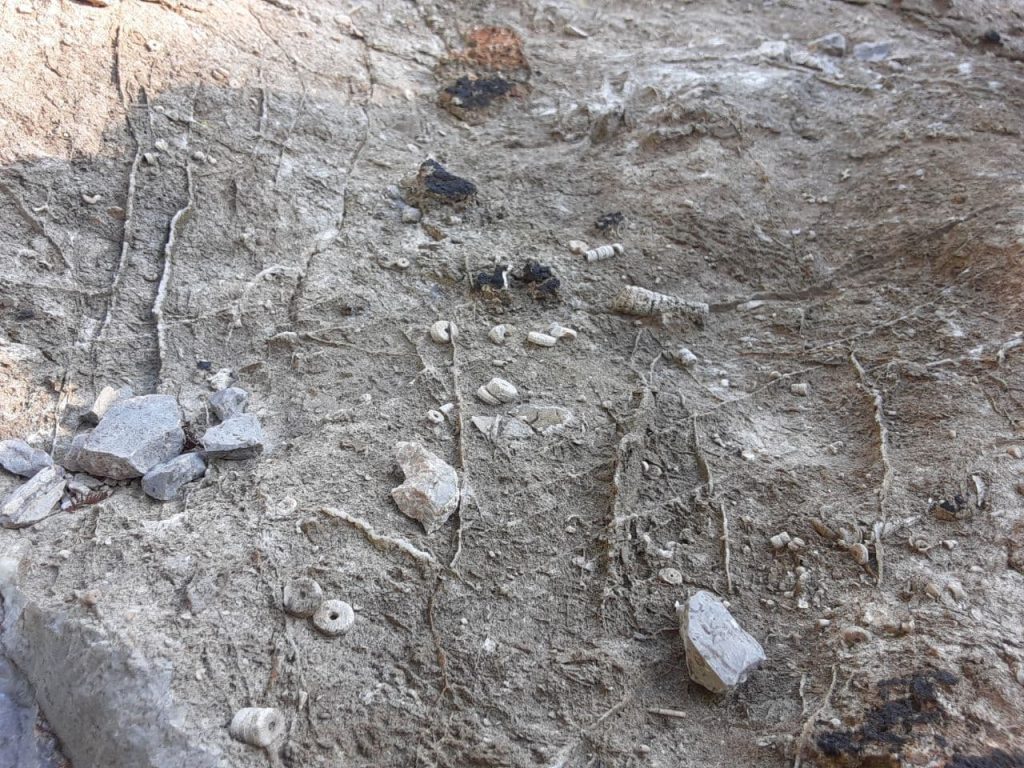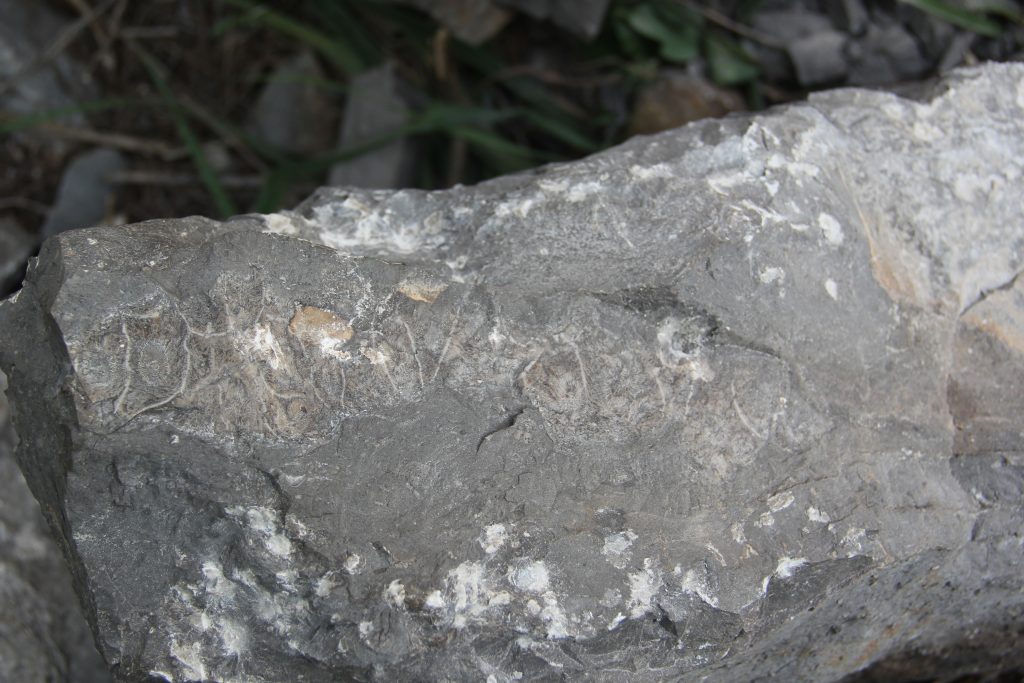ភ្នំទាក់ទ្រាំង មានទីតាំងភូមិសាស្រ្តស្ថិតនៅឃុំត្រែង ស្រុករតនមណ្ឌល ខេត្តបាត់ដំបង។ ភ្នំនេះគេហៅខ្លះថាភ្នំល្អាងស្ពាន ដែលជាស្ថានីយបុរេប្រវត្តិសាស្ត្រដ៏ចំណាស់មួយនៃប្រទេស កម្ពុជា ដែលត្រូវបានសិក្សាតាំងពីសម័យបារាំង និងបានបន្តសិក្សាដោយអ្នកបុរាណវិទ្យាខ្មែរក្នុងពេលបច្ចុប្បន្នផងដែរ។ ភ្នំទាក់ទ្រាំងត្រូវបានរាជរដ្ឋាភិបាលដាក់ជាតំបន់បេតិកភណ្ឌធម្មជាតិ ដោយអនុក្រឹត្យលេខ ០៦៧ អនក្រ.បក ចុះថ្ងៃទី២៥ ខែឧសភា ឆ្នាំ២០២០ ដែលមាន ៧៩,៨២ហិចតា។ ក្រុមការងារសិក្សាផូស៊ីលនៃនាយកដ្ឋានតំបន់បេតិកភណ្ឌ នៃអគ្គនាយកដ្ឋានសហគមន៍មូលដ្ឋាន ក្រួងបរិស្ថាន បានទៅសិក្សាបឋមនៅតំបន់ភ្នំទាក់ទ្រាំង និងភ្នំនៅជាប់នោះផងដែរ កាលពីឆ្នាំ២០២០កន្លងមក។

តំបន់ភ្នំទាក់ទ្រាំងជាប្រភេទភ្នំថ្មកំបោរ មានអតីតកាលជាសមុទ្រ មានសញ្ញាសំគាល់ PLS ក្នុងសម័យកាល Permian (២៥១-២៩៩លានឆ្នាំ) នាស័ក Paleozoic។ នៅក្នុងរូងភ្នំនៃភ្នំទាក់ទ្រាំងពុំសូវឃើញមានឃើញផូស៊ីលទេ ខ្លះនៅសល់ស្នាកស្នាមតិចតូចជាពិសេស តែយើងបានជួបប្រទះនោះផ្នែកខាងក្រៅនៃភ្នំ និងទីតាំងដែលគេវាតយថ្មនៅភ្នំជាប់នោះ ដែលរកឃើញពពួកសត្វសមុទ្រមួយចំនួនដូចជា៖ ពពួកគ្រីណូអ៊ីត Crinoid (រូបលេខ៤) ស្ថិតនៅ សាខា (Phylum) Echinodermata ក្រុម (class) Crinoidea។ ដែលសាខា Echinodermata មានក្រុមមួយចំនួនដែលស្ថិតនៅក្បែរពពួក Crinoidea មានផ្កាយសមុទ្រ និងពួកកាំប្រម៉ាសមុទ្រ យើងក៏ធ្លាប់បានចុះផ្សាយលើកមុនផងដែរ យើងបានជួនប្រទះពពួកគ្រីណួអ៊ីតនៅជើងភ្នំ ថ្មលេចចេញនៅតាមចំការនៃភ្នំមួយជាប់និងភ្នំទាក់ទ្រាំងដែលនៅមិនឆ្ងាយពីទីតាំងវាយថ្ម។ សត្វនេះក៏បានបន្តមករស់នៅដល់ពេលបច្ចុប្បន្នក្នុងប្រទេសកម្ពុជា គ្រាន់តែជាពូជន៍ផ្សេងគ្នាតែប៉ុណ្ណោះ។ ផូស៊ីលអាម៉ូណីតត្រូវបានជួបប្រទះនៅស្ថានីយផូស៊ីលសត្វសមុទ្រមួយចំនួនដូចជានៅភ្នំបាក់ ភ្នំជញ្ជាំង ភ្នំស្វាយ ភ្នំតូច ក្នុងខេត្តបន្ទាយមានជ័យ ដែលមានលក្ខណៈប្រហែលគ្នា នេះក៏អាចបង្ហាញអំពីទំនាក់ទំនងគ្នារវាងជិវិតដែលអាចស្ថិតក្នុងពេលប្រហាក់ប្រហែលគ្នា។

ផ្កាថ្មមួយប្រភេទរកឃើញនៅភ្នំមូយជាប់និងភ្នំទាក់ទ្រាំងក្នុងទីតាំងវាយថ្ម ដែលកប់ក្នុងទីតាំងនោះ។ ផ្កាថ្មនេះអាច អាចស្ថិតនៅក្នុង Colonial Rugosa Coral តែក៏មិនទាន់ដឹងថាវាជាប្រភេទមួយណាច្បាស់នៅឡើយទេ។ ពពួកនេះស្ថិតនៅសាខា Phylum Cnidaria, ថ្នាក់ (class) Anthozoa (coral), លំដាប់ Order Rugosa, colonial rugose coral។ ផ្កាថ្មនេះក៏មានលក្ខណៈប្រហាក់ប្រហែលនិងផ្កាថ្មមួយដែលឃើញនៅលើភ្នំបាក់ត្រង់កំពូលភ្នំ។

ផូស៊ីលមួយប្រភេទដែលមានរូបរៀងដូចជាបំពង់មានមុខកាត់ប្រមាណ៤ស.ម ដែលស្ថិតនៅក្នុង សាខា Phylum Porifera ( Spongy)។ យើងបានរកឃើញផូស៊ីលទាំងនេះនៅក្នុងបំណែកថ្មដែលកេវាយបំបែក។ Spongy មានបន្តរស់នៅរហូតដល់ពេលបច្ចុប្បន្ន វាមានលក្ខណៈប្រហាក់ប្រហែលផ្កាថ្ម តែរូបរាងកាយរបស់វា មិនសូវរឹង តន់ដូចអេប៉ុង។ ពួកនេះក៏បានរកឃើញនៅភ្នំបាក់ និងភ្នំស្វាយ ខេត្តបន្ទាយមានជ័យផងដែរ។
ជាស្នាកស្នាមផូស៊ីលជាប់នៅក្នុងថ្មកំបោរ ពួកវាក៏អាចស្ថិតនៅក្នុង សាខា Phylum Porifera ( Spongy) ដែរ។ ពូកនេះក៏បានជួបប្រទះនៅស្ថានីយផូស៊ីលសត្វសមុទ្រភ្នំស្វាយដែលមានលក្ខណៈដូចគ្នា។

ថ្វីត្បិតតំបន់ភ្នំទាក់ទ្រាំងមានការរកឃើញសំណាកផូស៊ីលសត្វសមុទ្រមិនច្រើន អាចដោយសារការរលាយចូលក្នុងសាច់ថ្មពិបាកក្នុងការពិនិត្យមើល។ តែតាមរយៈភស្តុតាងផូស៊ីលមួយចំនួនដែលយើងបានជួនប្រទះ និងប្រៀបធៀបជាមួយស្ថានីយមួយចំនួនដូចជានៅភ្នំបាក់ ភ្នំស្វាយក្នុងខេត្តបន្ទាយមានជ័យ។ យើងអាចដឹងថាស្ថានីយនេះពិតជាមានទំនាក់ទំនងរវាងជីវិតសត្វដែលស្ថិតនៅក្នុងសម័យកាលជាមួយគ្នា។ ភ្នំទាក់ទ្រាំងមានអតីតកាលនៅក្នុងសមុទ្រ ក្នុងសម័យកាល Permian (២៥១-២៩៩លានឆ្នាំ) នាស័ក Paleozoic។ ទីតាំងនេះក៏គួរតែមានការសិក្សាបន្ថែមនៅលើភ្នំមួយចំនួនដែលនៅនោះ៕
—————————————–
Fossils at Teak Trang Mountain
Teak Trang mountain is located in Treng commune, Ratanak Mondol district, Battambang province. This mountain is also called Phnom Laang Spean. It is a pre-history site of Cambodia that has been studied since the French colonization period. Teak Trang became a natural heritage site on May 25th, 2020. It covers 79.82 hectares.
Teak Trang is a limestone mountain that was an ocean area under the code of PLS and in the Permian period (251-299 million years) of Paleozoic. The caves of Teak Trang mountain do not have many fossils. However, there are many of them found outside of the caves. For instance, Crinoid of Echinodermata (Phylum) in the class of Crinoidea. The branch of Echinodermata has sea stars and sea urchins. Sometimes, Crinoid is found at the foot of the mountain and on the farm nearby. This species continues living in Cambodia up to the present. However, it is a different type.Fossils of Ammonite has been found at Phnom Bak, Phnom Chunh Cheang, Phnom Svay and Phnom Touch in Banteay Meanchey province.
There is a type of Coral that has been found from a mountain next to Teak Trang mountain. It is located on a stone quarry site. This Coral could be in the group of Colonial Rugosa Coral. However, the exact species is unknown. This Coral is in a branch of Phylum Cnidaria, class of Anthozoa, order Rugosa, Colonial rugose coral. This coral is similar to another coral found on the peak of Phnom Bak. Furthermore, there is a fossil with a cross-section of 4 cm in the branch of Phylum Porifera. These fossils have been found in the fragment of stone.
Spongy continue to live until the present. It has a similar characteristic as coral but is slightly soft as a sponge. Spongy have been found at Phnom Bak and Phnom Svay in Banteay Meanchey province. It is in the branch of Phylum Porifera.
Even though the area of Teak Trang mountain does not have many fossils, it could be compared and associated with other sites such as Phnom Bak and Phnom Svay. The presence of these fossils shows a correlation of other animals in the same period. The area of Teak Trang mountain was an ocean in the Permian period of Paleozoic. However, the limitation of the information about the fossils in the area suggests having further study.






